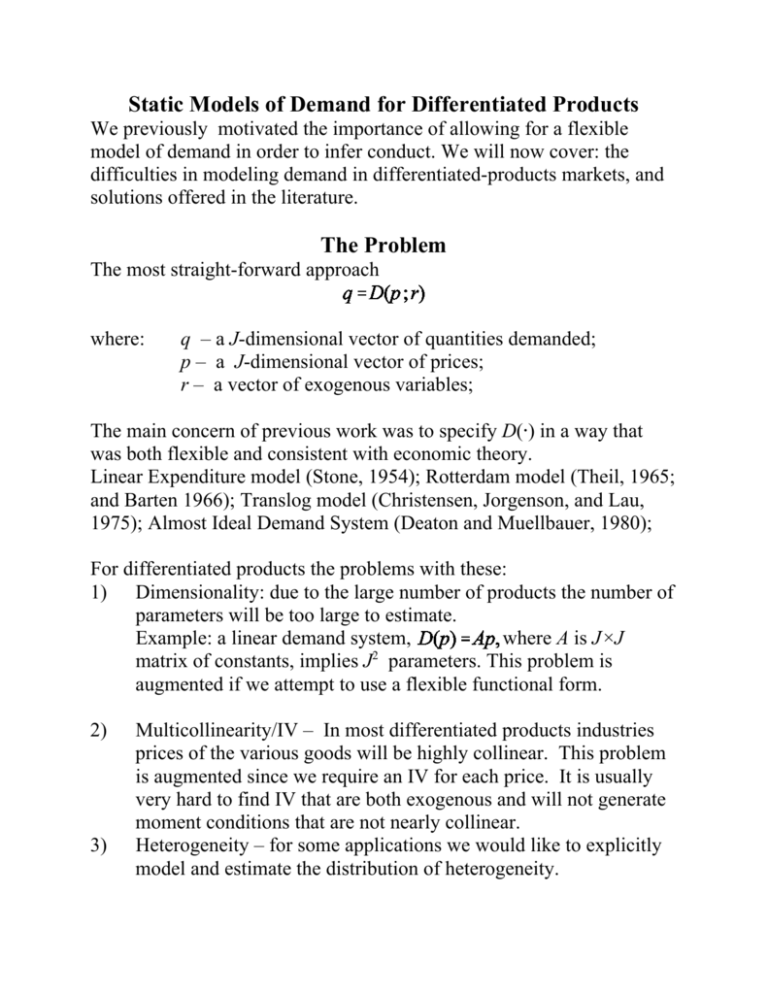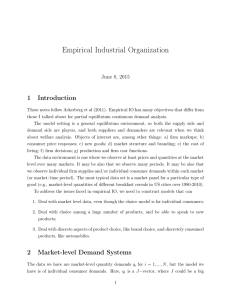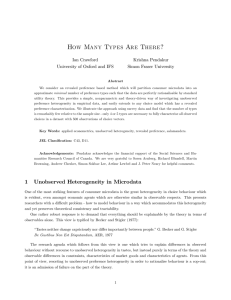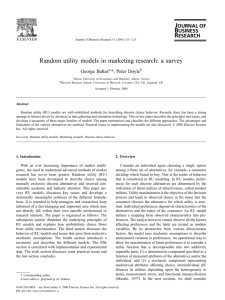Static Models of Demand for Differentiated Products The Problem
advertisement

Static Models of Demand for Differentiated Products We previously motivated the importance of allowing for a flexible model of demand in order to infer conduct. We will now cover: the difficulties in modeling demand in differentiated-products markets, and solutions offered in the literature. The Problem The most straight-forward approach where: q – a J-dimensional vector of quantities demanded; p – a J-dimensional vector of prices; r – a vector of exogenous variables; The main concern of previous work was to specify D(@) in a way that was both flexible and consistent with economic theory. Linear Expenditure model (Stone, 1954); Rotterdam model (Theil, 1965; and Barten 1966); Translog model (Christensen, Jorgenson, and Lau, 1975); Almost Ideal Demand System (Deaton and Muellbauer, 1980); For differentiated products the problems with these: 1) Dimensionality: due to the large number of products the number of parameters will be too large to estimate. Example: a linear demand system, where A is J×J 2 matrix of constants, implies J parameters. This problem is augmented if we attempt to use a flexible functional form. 2) 3) Multicollinearity/IV – In most differentiated products industries prices of the various goods will be highly collinear. This problem is augmented since we require an IV for each price. It is usually very hard to find IV that are both exogenous and will not generate moment conditions that are not nearly collinear. Heterogeneity – for some applications we would like to explicitly model and estimate the distribution of heterogeneity. Symmetric Representative Consumer Models These models solve the dimensionality problem imposing symmetry assumptions that restrict the patterns of substitution. Example 1: Constant elasticity of substitution (CES) utility: where D is a constant parameter that measures substitution across products. The demand of the representative consumer obtained from this utility function is where I is the income of the representative consumer. The dimensionality problem is solved by imposing symmetry between the different products; thus, estimation involves a single parameter. This model implies The cross-price elasticities are restricted to be equal, regardless of how “close” the products are in some attribute space. This model is popular in theory and is sometimes used in trade and in macro, but it is not appropriate for our purpose. Example 2: An alternative to the CES utility function is which yields the Logit demand. The utility function for the Logit representative consumer has two terms. The first suggests that the representative consumer will consume only the product with the highest *j. The second term is an entropy term and expresses a variety-seeking behavior. Through this second term we get consumption of more than one product, but its functional form illuminates the problem all products enter this entropy term in a symmetric way. Estimation of this model involves J parameters and allows for somewhat richer substitution patterns. As we discuss below the substitution patterns in the Logit model are solely a function of market shares (which here are equivalent to the quantities consumed by the aggregate consumer), and are not related to the characteristics of the products. Multi-Stage Budgeting The basic idea: solve the dimensionality problem by dividing the products into smaller groups and allow for a flexible functional form within each group. Multi-stage budgeting – the consumer maximization problem is split into several stages: – at the highest stage expenditure is allocated to broad groups; – at lower stages group expenditure is allocated to sub-groups; – At each stage the allocation decision is a function of only that group total expenditure and prices of commodities in that group (or price indexes for the sub-groupings). There are various conditions that will guarantee that the solution to this multi-stage process will equal the solution to the “full” problem. Weak separability of preferences: are the subwhere f(@) is some increasing function and utility functions associated with separate groups. Weak separability is necessary and sufficient for the last stage of the multi-stage budgeting; if a subset of products appears only in a separable sub-utility function, then the quantities demanded of these products can always be written as only a function of group expenditures and prices of other products within the group. In higher stages usually rely (1) indirect utility functions for each segment are of the Generalized Gorman Polar Form, and (2) the overall utility is separable additive in the sub-utilities. Originally developed for the estimation of broad categories of products. Hausman, Leonard, and Zona (1994) and Hausman (1996) use the idea of multi-stage budgeting to construct a multi-level demand system for differentiated products. Example: Beer (HLZ) or Cereal (Hausman). Upper level: category demand Middle level: segment demand Lower level: brand demand Each level allows for a flexible functional form; Assume the data is for j = 1, ... , J products in t = 1, ..., T markets: Lowest level : the Almost Ideal Demand System sjt is the dollar sales share of total segment expenditure, ygt is overall per capita segment expenditure, Bgt is the price index; pkt is the price of the kth brand in market t. The price index, Pgt, is computed as either the Stone logarithmic price index where: or the Deaton and Muellbauer exact price index The exact form of the price index does not seem to be very important for the results. If the latter is used the estimation is non-linear, while with the Stone index the estimation can be performed using linear methods. Middle level: log-log demand: where: qgt is the quantity of the gth segment in market t; YRt is total category (e.g., cereal) expenditure; Bkt are the segment price indexes; Top level: demand for the category is where: Qt is the overall consumption of cereal in market t; It is real income; At is the price index for the category; Zt are variables that shift demand; Estimation: From lowest level up; Linear or Non-linear (depending on price index); Usually impose cross-equation restrictions; Advantages: (1) Closely related to neo-classical demand; (2) Flexible within a segment; Disadvantages: (1) Requires division into segments; (2) The above example does not exactly satisfy theory; (3) Does not deal with: multicollinearity/IV or with heterogeneity; Spatial Models Combine neo-classical demand with a characteristics approach (Slade, UK brewing, Conley in various papers). Suppose demand is where: q is a J×1 vector of quantities; p is a J×1 vector of prices of the different products; g is a J×1 vector of error-terms; A is a J×1 vector of parameters; B is a J×J matrix of parameters; If J is large, then too many parameters to estimate. Their solution: where where: are the characteristics of product j. bii = parametric function of Xi; bij = non-parametric function of ; Disadvantages: (1) The estimated functions are not promised to satisfy the requirements of economic theory. Cannot use them for welfare. (2) Does not deal with: multicollinearity/IV or with heterogeneity; (3) Results are not very promising; Discrete Choice Models Essentially solve the dimensionality problem by projecting the products onto a characteristics space, making the relevant dimension the dimension of the characteristics. Let the (conditional) indirect utility of consumer i from product j in market t be where: yi is the income of consumer i; pjt is the price of product j in market t; xjt is a 1×K vector of observable characteristics of product j; >jt is an unobserved (by the econometrician) product characteristic; gijt is a mean zero stochastic term; is consumer’s i marginal utility from income; is K×1vector of individual specific taste-coefficients. Unobserved characteristics can include the impact of unobserved promotional activity, unquantifiable factors (“brand equity”) or systematic shocks to demand. We can model and capture and by brand- and market-specific dummy variables. Implicit in the specification: (1) Utility is quasi-linear; alternatives C-D , or ; (2) All consumers value the unobserved characteristic in the same way; (3) All consumers face the same product characteristics (prices) The consumer-level taste parameters are modeled (5) where: Di is a d×1 vector of “observed” demographic variables; vi unobserved consumer attributes; Pv*(A) is a parametric distribution; is either a non-parametric distribution known from other data sources or a parametric distribution with the parameters estimated elsewhere; A is a (K+1)×d matrix of coefficients; E is a (K+1)×(K+1) matrix of parameters. The specification of the demand system is completed with the introduction of an “outside good”: the consumers may decide not to purchase any of the brands. The indirect utility from this outside option is Normalize , B0 and F0 to zero; Let 2 = (21, 22). 21=(", $) contains the “linear” parameters; 22=(A, E,) the “non-linear” parameters. Combining the equations Consumers are assumed to purchase one unit of the good that gives the highest utility. Define: where are observed characteristics, prices and mean utility of all brands, respectively. Then, assuming ties occur with zero probability, the market share of the jth product is given by where P*(@) denotes population distribution functions. Given assumptions on the distribution of the (unobserved) individual attributes we can compute this integral. Distributional Assumptions (1) Logit: Set 22 = 0, which implies utility becomes for all i, and the indirect Assume that gijt are distributed iid according to a Type I extreme value distribution, then market share of brand j in market t, is Appealing, due to its tractability, it restricts the substitution patterns. The price elasticities are own-price elasticities roughly proportional to price (heterogeneity); cross-price elasticities do not depend on j (i.i.d. shocks); (2) Nested Logit: Divide the products into nests; Set 22 = 0, but allow for error components in gijt, so products in the same nest have correlated errors; This is equivalent to allowing a nest dummy variable as a characteristic and setting a particular distribution of its coefficient; Issues: Does not deal with own-price elasticities; Requires a-priori segments; Order of “nesting” matters; Principles of Differentiation Generalized Extreme Value model (Bresnahan, Stern and Trajtenberg) deals with this. (3) Random Coefficients Logit/Mixed Logit : Assume that gijt are distributed iid according to a Type I extreme value distribution (can also allow for nesting); Generate correlation through :ijt The price elasticities are where individual i purchasing product j. , is the probability of Patterns in own-price elas driven by heterogeneity; Patterns in cross -price elas driven by correlation in taste for characteristics: shocks for similar products will be correlated, In principle, this model is flexible enough to approximate any choice model. The cost is in the computation complexity; Advantages (of discrete choice): (1) Deals with all the problems we raised; (2) Relatively easy data requirements; Problems: (1) What if choice is not discrete? conceptual – define choice accordingly; data – can be an issue if we observe consumer-level data; questions – e.g., bundling; (2) Restrictive function form/too few parameters; (3) Identification; Extensions: Multiple Discreteness: Hendel (RES, 99) models the demand for computers by firms. Each firm buys several brands and several units. Models: (1) firms tasks – multiple brands; (2) decreasing MU from quantity – several units; Discrete-Continuous choice: Dubin-McFadden (EMA, 84) model the choice of appliance + amount of usage;











